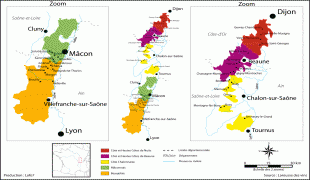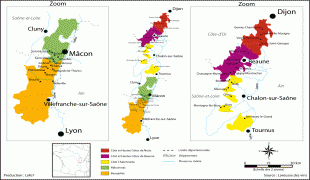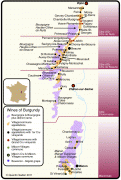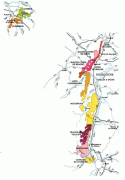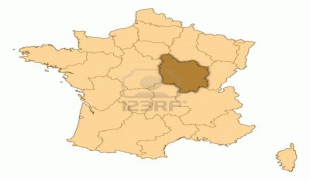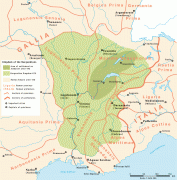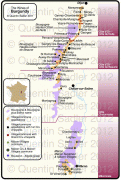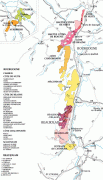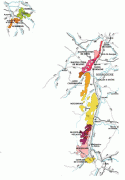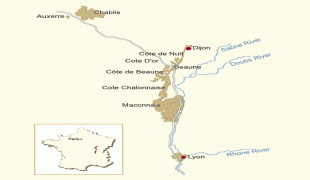Burgundy (Bourgogne)
 |
 |
Upon the 9th-century partitions of the Kingdom of Burgundy, the lands and remnants partitioned to the Kingdom of France were reduced to a ducal rank by King Robert II of France in 1004. The House of Burgundy, a cadet branch of the House of Capet, ruled over a territory that roughly conformed to the borders and territories of the modern administrative region of Burgundy. Upon the extinction of the Burgundian male line the duchy reverted to the King of France and the House of Valois. Following the marriage of Philip of Valois and Margaret III of Flanders, the Duchy of Burgundy was absorbed into the Burgundian State alongside parts of the Low Countries which would become collectively known as the Burgundian Netherlands. Upon further acquisitions of the County of Burgundy, Holland, and Luxembourg, the House of Valois-Burgundy came into possession of numerous French and imperial fiefs stretching from the western Alps to the North Sea, in some ways reminiscent of the Middle Frankish realm of Lotharingia.
The Burgundian State, in its own right, was one of the largest ducal territories that existed at the time of the emergence of Early Modern Europe. It was regarded as one of the major powers of the 15th century and the early 16th century. The Dukes of Burgundy were among the wealthiest and the most powerful princes in Europe and were sometimes called "Grand Dukes of the West". Through its possessions the Burgundian State was a major European centre of trade and commerce.
The extinction of the dynasty led to the absorption of the duchy itself into the French crown lands by King Louis XI, while the bulk of the Burgundian possessions in the Low Countries passed to Duke Charles the Bold's daughter, Mary, and her Habsburg descendants. Thus the partition of the Burgundian heritage marked the beginning of the centuries-long French–Habsburg rivalry and played a pivotal role in European politics long after Burgundy had lost its role as an independent political identity.
It is named for the Burgundians, an East Germanic people who moved westwards beyond the Rhine during the late Roman period. The name Burgundy has historically denoted numerous political entities. It first emerged in the 9th century as one of the successors of the ancient Kingdom of the Burgundians, which after its conquest in 532 had formed a constituent part of the Frankish Empire.
Since the inception of the French departmental system in 1790, Burgundy has referred to the geographic area comprising the four departments of Côte-d'Or, Saône-et-Loire, Yonne, and Nièvre.
Map - Burgundy (Bourgogne)
Map
Country - France
 |
 |
| Flag of France | |
Inhabited since the Palaeolithic era, the territory of Metropolitan France was settled by Celtic tribes known as Gauls during the Iron Age. Rome annexed the area in 51 BC, leading to a distinct Gallo-Roman culture that laid the foundation of the French language. The Germanic Franks formed the Kingdom of Francia, which became the heartland of the Carolingian Empire. The Treaty of Verdun of 843 partitioned the empire, with West Francia becoming the Kingdom of France in 987. In the High Middle Ages, France was a powerful but highly decentralised feudal kingdom. Philip II successfully strengthened royal power and defeated his rivals to double the size of the crown lands; by the end of his reign, France had emerged as the most powerful state in Europe. From the mid-14th to the mid-15th century, France was plunged into a series of dynastic conflicts involving England, collectively known as the Hundred Years' War, and a distinct French identity emerged as a result. The French Renaissance saw art and culture flourish, conflict with the House of Habsburg, and the establishment of a global colonial empire, which by the 20th century would become the second-largest in the world. The second half of the 16th century was dominated by religious civil wars between Catholics and Huguenots that severely weakened the country. France again emerged as Europe's dominant power in the 17th century under Louis XIV following the Thirty Years' War. Inadequate economic policies, inequitable taxes and frequent wars (notably a defeat in the Seven Years' War and costly involvement in the American War of Independence) left the kingdom in a precarious economic situation by the end of the 18th century. This precipitated the French Revolution of 1789, which overthrew the Ancien Régime and produced the Declaration of the Rights of Man, which expresses the nation's ideals to this day.
Currency / Language
| ISO | Currency | Symbol | Significant figures |
|---|---|---|---|
| EUR | Euro | € | 2 |
| ISO | Language |
|---|---|
| EU | Basque language |
| BR | Breton language |
| CA | Catalan language |
| CO | Corsican language |
| FR | French language |
| OC | Occitan language |







